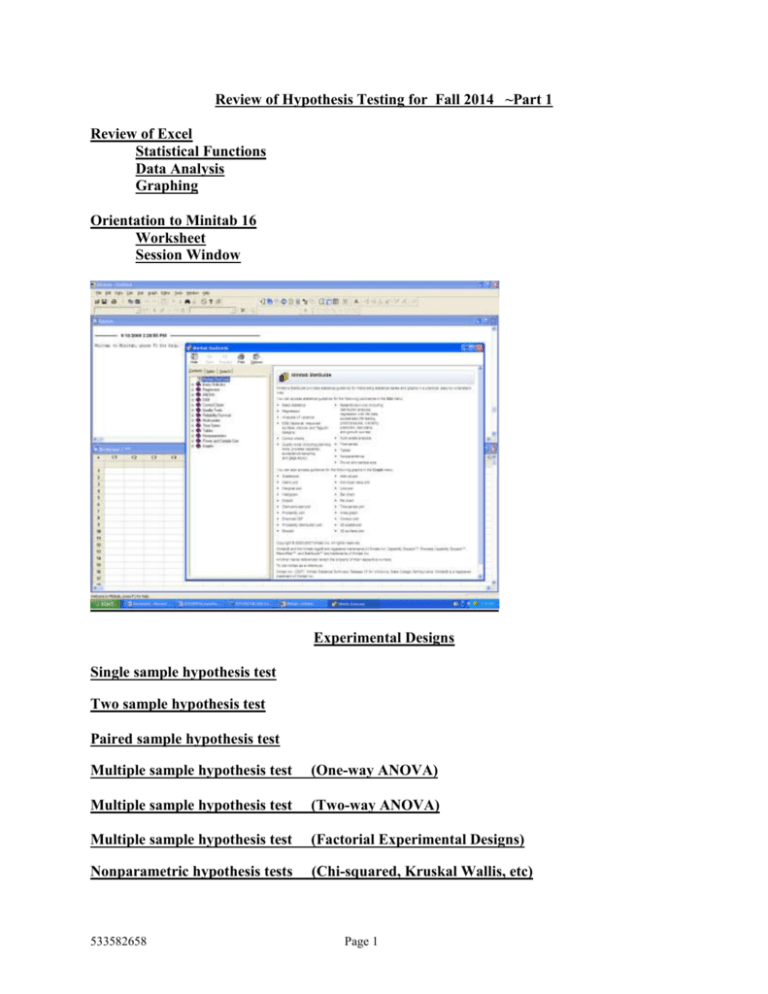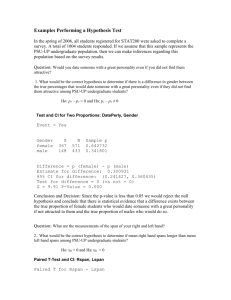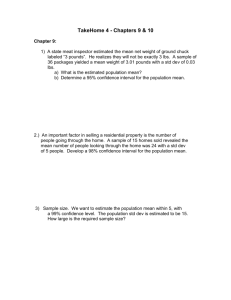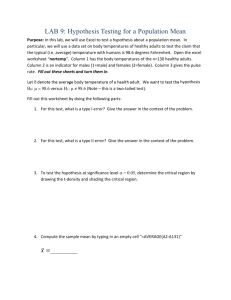BurtnerFall2014HypothesisTestingExamplesPart1REV3 no quiz
advertisement

Review of Hypothesis Testing for Fall 2014 ~Part 1 Review of Excel Statistical Functions Data Analysis Graphing Orientation to Minitab 16 Worksheet Session Window Experimental Designs Single sample hypothesis test Two sample hypothesis test Paired sample hypothesis test Multiple sample hypothesis test (One-way ANOVA) Multiple sample hypothesis test (Two-way ANOVA) Multiple sample hypothesis test (Factorial Experimental Designs) Nonparametric hypothesis tests (Chi-squared, Kruskal Wallis, etc) 533582658 Page 1 533582658 Page 2 Single sample hypothesis test If a random sample of 20 servings of ready-to-eat cereal has a mean sodium content of 244 milligrams and a standard deviation of 24.5 milligrams, does this data suggest that the average sodium content is greater than 220 milligrams? Assume the distribution of sodium contents to be normal. Factor Level(s) (What are the groups or categories?) Cereal (single factor) Response: (What is being measured?) Sodium content (mg) Hypotheses: = 220 > 220 H 0: H 1: Calculation of test statistic and p-value: unknown Use t n 20 t calc X s n t calc 244 220 24.5 20 t calc 4.38 There is no value for tcrit The p-value associated with tcalc = 4.38 is very small. How do we find the exact p-value? Method 1: We can use an Excel function (TDIST) Note that Excel uses positive values for t and tells us the area to the right of the selected value of t. 0.000161 =TDIST(4.38,19,1) Method 2: We can use the Minitab pull-down menu: Stat/Basic Statistcis/1-Sample t Test of mu = 220 vs > 220 N 20 Mean 244.000 StDev 24.500 SE Mean 5.478 95% Lower Bound 234.527 T 4.38 P 0.000 Graphics: t Distribution -4.0 -3.0 -2.0 -1.0 0.0 1.0 2.0 3.0 4.0 Standard Score (t) **OR** 0 0.05 0.50 Note that the p-value is very close to zero. Therefore, it is highly unlikely that H0 is true. Decision: 1 p-value Reject H0 Conclusion: With a p-value = 0.00016, the data suggest that the population mean (µ) sodium content is greater than 220 milligrams. 533582658 Page 3 Two sample hypothesis test (summarized data) A random sample of 9 servings of Crowger Corn Flakes has a mean sodium content of 243.89 milligrams and a standard deviation of 2.47 milligrams, A random sample of 9 servings of Publicks Corn Flakes has a mean sodium content of 247.11 milligrams and a standard deviation of 5.35 milligrams. Does this data suggest that two brands differ in terms of average sodium content? Assume the distribution of sodium contents to be normal. Factor Level(s) (What are the groups or categories?) Cereal Brand: Crowger or Publicks Response: (What is being measured?) Sodium content (mg) Hypotheses: Crowger = Publicks Crowger ≠ Publicks H 0: H 1: Correct test statistic: t Calculation of test statistic and p-value: Method 1: We can use the Minitab pull-down menu: Stat/Basic Statistcis/2-Sample t Two-Sample T-Test and CI: CFlakes, PFlakes Two-sample T for CFlakes vs PFlakes CFlakes PFlakes N 9 9 Mean 243.89 247.11 StDev 2.47 5.35 SE Mean 0.82 1.8 Difference = mu (CFlakes) - mu (PFlakes) Estimate for difference: -3.22222 95% CI for difference: (-7.54537, 1.10092) T-Test of difference = 0 (vs not =): T-Value = -1.64 P-Value = 0.129 DF = 11 Graphics: p = 0.129 0 Decision: 0.05 0.10 1 p-value Fail to reject H0 Conclusion: With a p-value = 0.129, the data suggest that there is not a statistically significant difference in the mean sodium content of the two brands. 533582658 Page 4 Two sample hypothesis test (raw data) A quality researcher is interested in comparing the sodium content of two brands of corn flakes. She collects the following data. Does this data suggest that two brands differ in terms of average sodium content? Assume the distribution of sodium contents to be normal. CFlakes 244 245 246 248 241 241 245 244 241 PFlakes 254 256 245 244 242 243 243 245 252 Hypotheses: H 0: H 1: Crowger = Publicks Crowger ≠ Publicks Critical values: *small sample *sigma unknown *two-sided alternate hypothesis *p-value approach ~Therefore, there is no value for t critical. Calculation of test statistic and p-value: Method 1: We can use the Minitab pull-down menu: Stat/Basic Statistcis/2-Sample t Two-Sample T-Test and CI: CFlakes, PFlakes Two-sample T for CFlakes vs PFlakes CFlakes PFlakes N 9 9 Mean 243.89 247.11 StDev 2.47 5.35 SE Mean 0.82 1.8 Difference = mu (CFlakes) - mu (PFlakes) Estimate for difference: -3.22222 95% CI for difference: (-7.54537, 1.10092) T-Test of difference = 0 (vs not =): T-Value = -1.64 P-Value = 0.129 DF = 11 Graphics: 0 Decision: 0.05 0.10 1 (p-value) Fail to reject H0 Conclusion: With a p-value = 0.129, the data suggest that there is not a statistically significant difference in the mean sodium content of the two brands. 533582658 Page 5 Paired sample hypothesis test A quality researcher is interested in comparing the sodium content of two brands of corn flakes. Both brands are produced at a cereal plant in Making, Georgia. The researcher collects the following data. The samples are collected in 15-minute intervals beginning at 8:00 am. Does this data suggest that two brands differ in terms of average sodium content? Assume the distribution of sodium contents to be normal. Time 8:00 8:15 8:30 8:45 9:00 9:15 9:30 9:45 CrFlakes 244 245 246 246 241 241 245 244 WaFlakes 246 248 245 245 249 248 247 249 The times listed indicate that we should pair the data collected. The Minitab results for a paired sample t-test are shown below. Paired T-Test and CI: CrFlakes, WaFlakes Paired T for CrFlakes - WaFlakes N 8 8 8 CrFlakes WaFlakes Difference Mean 244.000 247.125 -3.12500 StDev SE Mean 2.000 0.707 1.642 0.581 3.35676 1.18679 95% CI for mean difference: (-5.93132, -0.31868) T-Test of mean difference = 0 (vs not = 0): T-Value = -2.63 P-Value = 0.034 Graphics: 0 Decision: 0.05 0.10 1 p-value Reject H0 Conclusion: With a p-value = 0.034, the data suggest that there is a statistically significant difference in the mean sodium content of the two brands. 533582658 Page 6









